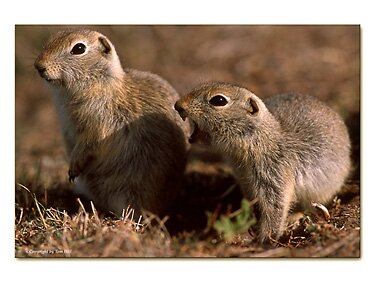

All Images And Text On This Site Are Copyright 1999-2001
by
Thomas D. Hill Jr.
| ABOUT KEIKO |
| WHAT'S NEW |
| THE KEIKO GALLERY |
| EQUIPMENT |
| IMAGE OF THE MONTH |
| ARTICLE OF THE MONTH |

25 June 01
Though not readily known outside of the praries of North America, Richardson Ground Squirrels are one of the Keystone species in this environment. What's meant by that is many other species depend on these squirrels for their survival. Whether because their prey for local predators, or that they provide shelter because of their abandon underground tunnels, these animals are critical to the prarie eco-system. Without getting into the heavy handed significance of them, Richardson Ground Squirrels are just plain cute.
Every year in late spring or early summer, the young make their way out from the underground dens to feast on the folage surrounding their homes. Most of their days are spent running from one burrow to another doing whatever they do. Many times, they can been seen wrestling as they scamper across the fields. But mostly, they spend their time searching for potential threats and eating. Curiously, adults aren't nearly has common out in the fields as their young are. These guys were part of a huge colony on the road between the eastern and western portions of Cypress Hills PP in Sasketchewan. Their homes located on the sides of the road, they could be found scurrying from one entry to another without regard to cars cruising down the dirt road. Many times, the squirrels aren't lucky and get "squished" as they run across the road--bad visual, sorry. Anyway, nothing goes to waste and the carcass is soon consumed by a passing raven.
I had spent the afternoon trying to make more than the standard, typical image of these guys. Usually they're found hiding inside their holes waiting for the threats to retreat so they could go on to real meaningful activities such as pigging out on the local folage. I spent most of three hours at one hole hoping a squirrel and his buddy would emerge so I could take their images. After dozens of head shots of squirrels peaking from the safety of their holes, I practically gave up that I would ever take the image I had in mind. I almost packed my gear and decided to try once more using a different tactic.
I setup my gear at a hole that had shown lots of juvenile activity and walked away. As expected when I approached, the squirrels scurried off to their retreats and watched as I set up my gear. After that, I walked away at a safe 20 or 30 yards, and waited to see if any would emerge from their dens. About 20 minutes later, the first then second squirrel emerged. Soon two more emerged and fed on the grass near their hole. So with the greatest of care, slowly walked towards my gear one step at a time. I tried to time my moves to when they were looking away. Surprisingly, I made it to within 20 feet before they noticed my presence and show a bit of concern. As slowly as I could, I moved into position with my cameras which didn't seem to affect them that much. They squawked a lot but didn't want to run away. Gawd this was lucky. How long would it last I thought. Well it lasted for almost 90 minutes. I saw two or three squirrels during the entire period. My eye glued to the camera. The worse part was I only had half a roll of film and didn't want to risk changing it without scaring the little guys away. That, I thought would've been too much movement.
Anyway, I eventually got this shot. The greatest challenge was getting enough Depth of Field (DOF) so that both of them were sharp. The way to increase DOF is to stop down or use smaller apertures. This means slower shutter speeds which means subject movement gets really obvious. So, my selections were a compromise which seems to have worked out.
Cheers,
Tom